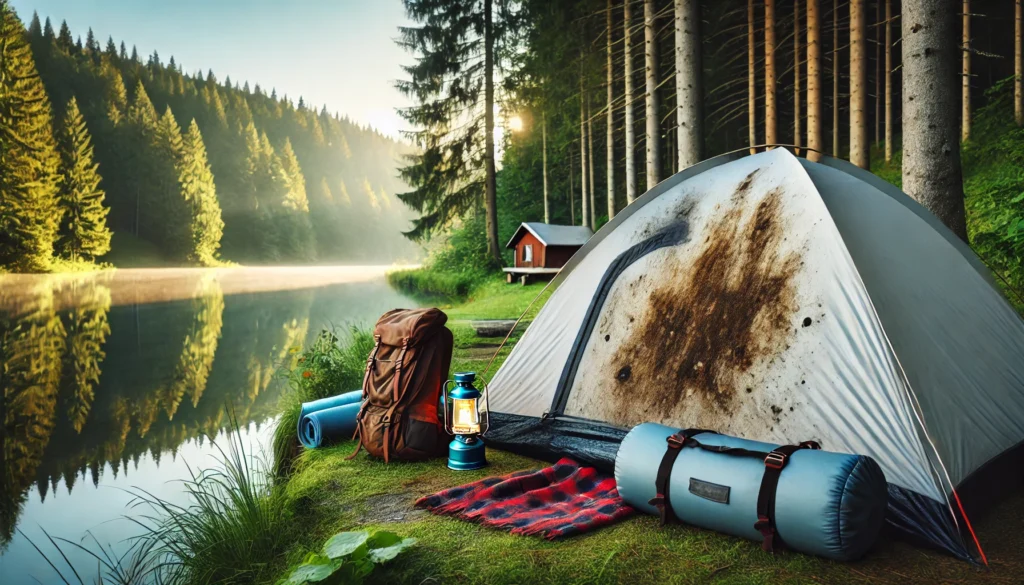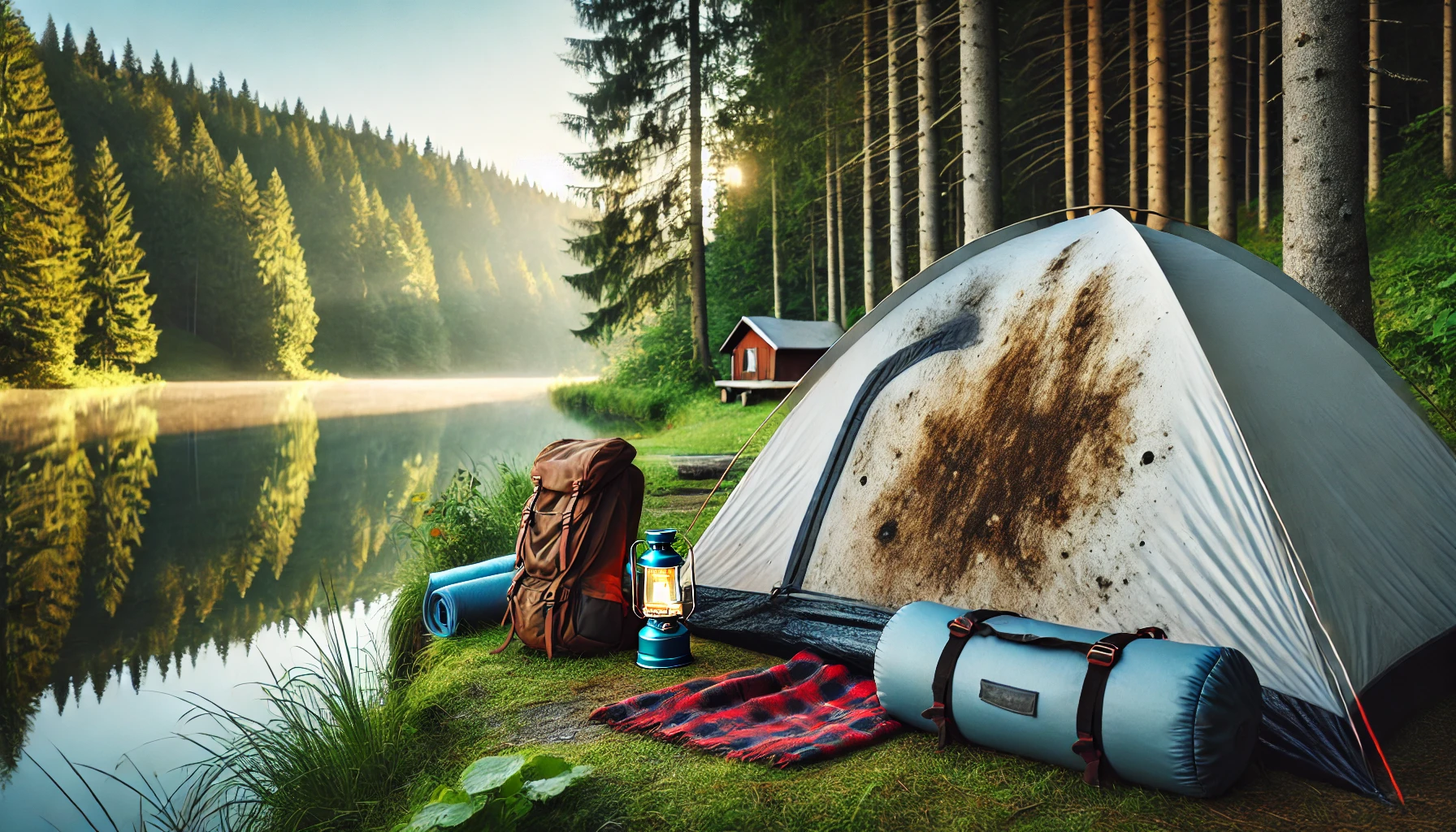This blog post may contain affiliate links. As an Amazon Associate I earn from qualifying purchases.
How to Remove Mold from Tent: Simple Steps I Learned After 15 Years of Camping

Picture this: You’re getting ready for your camping trip, pull out your tent, and there it is – the dreaded sight of mold. Trust me, I’ve been there, and it’s not just about the unpleasant surprise. Mold can completely destroy your tent within 24 hours if left unchecked. After countless camping trips over 15 years, I’ve mastered the art of removing mold from tent surfaces safely and effectively.
The scariest part? Black mold doesn’t just look bad – it’s a serious health hazard, especially if you or your camping buddies have asthma or allergies. I’ve seen perfectly good tents ruined by mold, developing nasty rot, holes, and tears. But don’t worry! Through years of trial and error, I’ve put together a foolproof cleaning system using both store-bought cleaners and simple household items like vinegar.
Let me walk you through my battle-tested methods for beating tent mold. From spotting different types of growth to applying the right cleaning solutions, I’ll show you exactly what works and what doesn’t. Whether you’re dealing with a tiny spot of mold or facing a full-blown infestation, you’ll learn everything you need to save your tent and keep it mold-free for future adventures.
Understanding Tent Mold Basics
Let me tell you something about tent mold – it’s every camper’s nightmare. This sneaky fungus loves damp, dark spaces and doesn’t need sunlight like regular plants. Instead, it feeds on organic matter and spreads through tiny spores in the air or water.
What causes mold growth in tents
You know what mold absolutely loves? The perfect combo of moisture, darkness, and warmth. I’ve learned the hard way that leaving your tent damp or storing it in humid conditions without good airflow is basically sending mold an invitation to move in – and it can happen within just 24 hours. The same goes for keeping wet gear inside your tent or pitching it in humid areas without proper ventilation.
Common types of tent mold
Over my years of camping, I’ve seen all sorts of tent mold. Most commonly, it shows up as fuzzy, discolored patches. If you’ve got a light-colored tent, black or green mold really stands out, though sometimes it can be white. Then there’s mildew, which is like mold’s less aggressive cousin – it looks more like powdery gray or yellow spots. Here’s a tip from my experience: if you catch a musty smell, that’s usually your first warning sign, even before you can see anything.
Health risks of camping with moldy tents
While healthy folks might not react too badly to mold, sleeping in a moldy tent isn’t something I’d recommend to anyone. Here’s what you might experience:
- Breathing difficulties
- Skin rashes and irritation
- Allergic responses
- Irritated eyes and throat
Black mold is particularly nasty – it releases toxins that can be really harmful. If you’ve got a weakened immune system, you’ll want to be extra careful around black mold. And it’s not just your health at risk – mold can absolutely destroy your tent fabric, eating away at the fibers until you’re left with a rotting, hole-filled mess.
Pro Tip: I always do a quick tent check before and after trips – looking for musty smells or slight discoloration. Trust me, catching mold early will save you loads of headache later.
Note: If your tent smells like cat pee, that’s usually really bad news – it might mean the mold damage is beyond fixing.
Essential Cleaning Supplies for Mold Removal
Let’s talk about cleaning supplies! After spotting mold in your tent, you’ll need the right tools for the job. Through countless cleaning sessions over the years, I’ve figured out exactly what works – both store-bought products and some clever natural solutions.
Best mold removal products for tents
I’ve tried pretty much every tent cleaner out there, and here are the real winners. GK Greener Kleener is my go-to choice – it knocks out 99.9% of mold while staying gentle on the environment with its neutral pH of 6. Revivex Pro Cleaner is another fantastic option that won’t mess with your tent’s water-repellent coating.
Got stubborn tent odors? Revivex Odor Eliminator is your best friend – it works like magic without harsh chemicals. I also really like Kampa Awning & Tent Cleaner – it’s eco-friendly and leaves your tent smelling like fresh strawberries while protecting the fabric.
Natural cleaning alternatives
Here’s a little secret from my camping toolkit – plain old white vinegar works wonders! Just mix it 50-50 with water, and you’ve got yourself a powerful mold fighter. Another trick I’ve learned is combining salt, lemon, and hot water – it tackles mold without harming your tent.
You can also make a paste with baking soda for gentle cleaning. But whatever you do, please don’t use bleach – I’ve seen it destroy too many good tents and their waterproof coatings.
Safety equipment needed
Folks, don’t skip the safety gear – mold isn’t something to mess around with. Here’s what you need:
- Good protective goggles for your eyes
- Sturdy gloves to protect your hands from cleaning solutions
- A proper face mask to keep those mold spores out
Essential cleaning tools:
- Soft brush or sponge (nothing too abrasive!)
- Large container or bathtub for soaking
- Clean cloths for applying solution and drying
Pro tip: Don’t forget to re-waterproof your tent after cleaning – trust me, you’ll thank me later.
Product Recommendations:
Here’s something I learned the hard way: always test your cleaning solution on a small hidden spot first. Better safe than sorry when it comes to protecting your tent’s fabric and waterproofing!
Step-by-Step Mold Cleaning Guide
Ready to tackle that mold? Great! After countless tent-cleaning sessions over the years, I’ve perfected a method that really works. Let me share my step-by-step process that’ll help you clean your tent without damaging it.
Preparing your tent for cleaning
Pick a nice, clear sunny day and set up your tent outside. This makes it super easy to spot all the moldy areas, plus you won’t spread those nasty spores inside your house. Grab a soft brush and gently sweep away any loose mold particles. Got a canvas tent? Make sure to separate the floor from the canopy – they need different cleaning approaches.
Applying cleaning solutions safely
Start small with spot cleaning. My favorite natural mix is equal parts white vinegar and water, but the salt-lemon-hot water combo works great too. Use gentle, circular motions with your soft brush – rough scrubbing is your tent’s worst enemy.
Dealing with stubborn mold? Here’s my deep-cleaning bath method:
- Fill a large container with warm water (about 1 foot deep)
- Add your chosen cleaner (follow those instructions carefully!)
- Submerge the whole tent
- Let it soak 4-10 hours, giving it a gentle stir now and then
Important: Watch that soaking time like a hawk – too long and you’ll kiss your waterproofing goodbye.
Drying and storage tips
After cleaning:
- Rinse, rinse, and rinse again until there’s no soap left
- Find a nice shady spot to set up
- Unzip everything for maximum airflow
- Give it a full 24-48 hours to dry completely
Pro Tip: Run your hands over every inch of that fabric – even tiny damp spots can turn into a mold party.
Remember: I can’t stress this enough – a damp tent in storage is basically a mold invitation. Make sure it’s bone dry before packing it away.
Preventing Future Mold Growth
Proper tent storage and moisture control are your strongest weapons against mold. After rescuing countless tents from mold disasters over my camping years, I’ve figured out exactly what works and what doesn’t.
Proper tent storage techniques
Here’s something every camper should know – how you store your tent makes or breaks its survival. The golden rule? Make sure it’s completely dry. I mean bone dry. Even a tiny bit of moisture can spark mold growth within 24 hours.
Forget that tiny stuff sack your tent came in. I learned to store mine loosely in a big, breathable cotton bag or mesh duffel. Your tent needs to breathe, just like we do!
Pick a cool, dry spot away from sunlight for storage. Basements and attics might seem convenient, but trust me – they’re mold magnets. Here’s my tried-and-tested storage checklist:
- Toss in some silica gel packets – they’re moisture-fighting champions
- Keep your tent off the ground – those pesky rodents love camping too
- Store poles and pegs separately – I’ve seen too many torn tents from stored hardware
Moisture control methods
Smart campsite setup is half the battle won. I love setting up under trees – they’re natural temperature regulators and help manage condensation. Here’s what else works:
Ventilation strategies:
- Point those tent doors where the breeze flows
- Create a gap between your rainfly and tent walls
- Keep those vents open – especially the ones opposite each other for good airflow
Pro tip: A tent fly cover is worth every penny – it fights UV damage and helps manage moisture like a champ.
Recommended Products:
- Coleman Dry Storage Bag (Breathable cotton)
- Moisture-Guard Silica Gel Packets (Large pack)
- Tent Platform Kit (Portable elevation system)
Don’t forget to check on your stored tent now and then. Even with perfect storage, I make it a habit to inspect my gear regularly. It’s amazing how catching small issues early can prevent big headaches later.
Conclusion
You know what? After 15 years of battling tent mold, I can tell you it’s not as scary as it seems. With the right knowledge and a bit of care, your tent can stay mold-free for countless adventures to come.
You know what’s funny? When I first started camping, tent mold used to terrify me. Now, after countless trips and even more mold battles, I can honestly say it’s nothing to lose sleep over. The secret? Catching those sneaky spots early and jumping into action before they take over your tent.
I’ve learned that a quick tent check after every adventure is worth its weight in gold. Just like checking your gear before a big trip, this simple habit has saved me from replacing perfectly good tents. The satisfaction of unzipping a clean, fresh-smelling tent at your campsite? Absolutely priceless.
Think of your tent as your wilderness palace – it keeps you safe from rain, wind, and those curious critters outside. Whether you’re team specialized-cleaner or prefer my trusty vinegar solution, remember this: thorough cleaning and proper drying are your tent’s best friends. Give your outdoor shelter the care it deserves, and it’ll keep you cozy through years of starlit nights and morning birdsongs.


